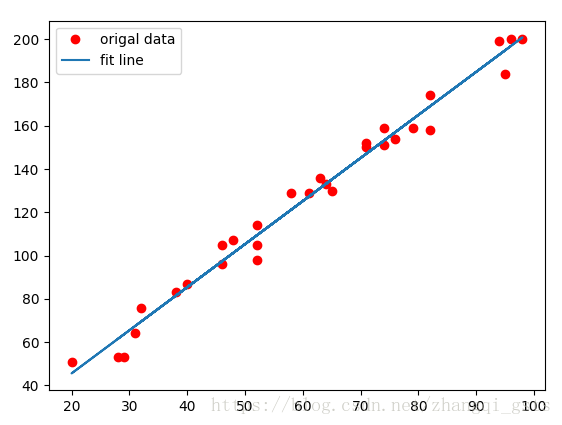线性回归,我们在初中就开始接触了,二维平面给出一些点,用一条直线拟合这些点。但实际情况下,这些点中都会有一些噪点、误差,那么怎么才能找出一条拟合度最好的直线呢?比如下图是y=2x+4的点,随机加入一些误差后怎么才能得到拟合最好的直线。

要判断好还是不好,首先要有一个度量指标,其次这个指标可以容易转换成数学运算。这里引出一种方法:最小二乘法。 最小二乘的思路步骤如下: 1. 假设拟合直线为y=ax+b。2.对任意一点。3. 误差表示为
。4. 当
最小时拟合度最好。简单说,最小二乘法计算的是y的拟合值与实际值的差平方,而不是点
到直线的垂直距离,主要是因为计算点到直线的距离计算量比较复杂,而且也没必要。
知道了拟合好坏的衡量标准,那么机器学习的目的就是不断优化减小这个值。
复制代码
1
2
3
4
5
6
7
8
9
10
11
12
13
14
15
16
17
18
19
20
21
22
23
24
25
26
27
28
29
30
31
32
33
34
35
36
37
38
39
40
41
42
43
44
45
46
47
48
49
50
51
52
53
54
55
56
57
58
59
60
61#!/usr/bin/python #encoding=utf-8 import tensorflow as tf import numpy as np import matplotlib.pyplot as plt learn_rate = 0.01 #y=2x+4 #随机生成y=2x+4的一些坐标点 train_X = [np.random.randint(20, high=100) for x in range(30)] train_Y = [2*x+4+np.random.randint(-10, high=10) for x in train_X] #转成成numpy数组 train_X = np.array(train_X) train_Y = np.array(train_Y) n_samples = train_X.shape[0] #用placeholder定义X和Y变量,具体值在训练的是用feed_dict填充 X = tf.placeholder(tf.float32) Y = tf.placeholder(tf.float32) #定义初始化W和b,一般不建议置0,用随机值初始化 W = tf.Variable(np.random.random(), name="weigth") b = tf.Variable(np.random.random(), name="bias") #带预测的线性方程 prediction = tf.add(tf.multiply(X, W), b) #用最小二乘定义损失函数 cost = tf.reduce_mean(tf.square(prediction - Y)) #这里优化器并没有用梯度下降,而用的是Adam优化器,后面说明,优化,使得cost最小 #optimizer = tf.train.GradientDescentOptimizer(learn_rate).minimize(cost) optimizer = tf.train.AdamOptimizer(learn_rate).minimize(cost) init = tf.global_variables_initializer() with tf.Session() as sess: sess.run(init) for i in range(1000): for (x, y) in zip(train_X, train_Y): #执行定义的优化器,填充placeholder定义的变量 sess.run(optimizer, feed_dict={X:x, Y:y}) if i % 50 == 0: #每隔50次打印一次cost,由于cost依赖X和Y,所以也需要用feed_dict填充 c = sess.run(cost, feed_dict={X: train_X, Y: train_Y}) print("Epoch:", '%04d' % i, "cost=", "{:.9f}".format(c), "W=", sess.run(W), "b=", sess.run(b)) print("Optimization Finished!") training_cost = sess.run(cost, feed_dict={X: train_X, Y: train_Y}) print("Training cost=", training_cost, "W=", sess.run(W), "b=", sess.run(b)) plt.plot(train_X, train_Y, 'ro', label="origal data") plt.plot(train_X, sess.run(W) * train_X + sess.run(b), label="fit line") plt.legend() plt.show()
执行结果如下:
复制代码
1
2
3
4
5
6
7
8
9
10
11
12
13
14
15
16
17
18
19
20
21
22Epoch: 0000 cost= 4224.109863281 W= 1.0521932 b= 1.1191503 Epoch: 0050 cost= 36.584716797 W= 2.037287 b= 2.5342977 Epoch: 0100 cost= 36.166492462 W= 2.029028 b= 3.1004112 Epoch: 0150 cost= 35.803798676 W= 2.0202172 b= 3.6987798 Epoch: 0200 cost= 35.565029144 W= 2.0129821 b= 4.196062 Epoch: 0250 cost= 35.420043945 W= 2.0074644 b= 4.5785236 Epoch: 0300 cost= 35.332836151 W= 2.0033123 b= 4.8672404 Epoch: 0350 cost= 35.279922485 W= 2.0001948 b= 5.0842767 Epoch: 0400 cost= 35.247253418 W= 1.9978536 b= 5.247259 Epoch: 0450 cost= 35.226734161 W= 1.9960959 b= 5.3696275 Epoch: 0500 cost= 35.213581085 W= 1.9947772 b= 5.4614873 Epoch: 0550 cost= 35.204982758 W= 1.9937861 b= 5.5304694 Epoch: 0600 cost= 35.199237823 W= 1.9930426 b= 5.5822573 Epoch: 0650 cost= 35.195346832 W= 1.9924846 b= 5.6211405 Epoch: 0700 cost= 35.192630768 W= 1.9920651 b= 5.650337 Epoch: 0750 cost= 35.190742493 W= 1.9917507 b= 5.672256 Epoch: 0800 cost= 35.189373016 W= 1.9915143 b= 5.688697 Epoch: 0850 cost= 35.188400269 W= 1.9913368 b= 5.7010508 Epoch: 0900 cost= 35.187698364 W= 1.9912037 b= 5.710329 Epoch: 0950 cost= 35.187175751 W= 1.9911035 b= 5.717318 Optimization Finished! Training cost= 35.186806 W= 1.9910296 b= 5.7224526
最后得到W是1.9,b是5.7,由于加入了噪点,所以b比实际的y=2x+4中的4偏大

注意上面,在定义优化器的时候并没有用梯度下降,因为在用梯度下降的时候训练几次就会出现nan。
复制代码
1
2
3Epoch: 0000 cost= inf W= -9.956399e+27 b= -1.1271411e+26 Epoch: 0001 cost= nan W= nan b= nan Epoch: 0002 cost= nan W= nan b= nan
原因是设置学习速率太快了,很快就溢出。解决办法有两种,一种是不用梯度下降,而采用Adam,另一种办法是不将损失函数的最小二乘法做一下修改,改成cost = tf.reduce_sum(tf.pow(prediction-Y, 2) / (2*n_samples))
最后
以上就是迷人小天鹅最近收集整理的关于TensorFlow基础之线性回归的全部内容,更多相关TensorFlow基础之线性回归内容请搜索靠谱客的其他文章。
本图文内容来源于网友提供,作为学习参考使用,或来自网络收集整理,版权属于原作者所有。








发表评论 取消回复